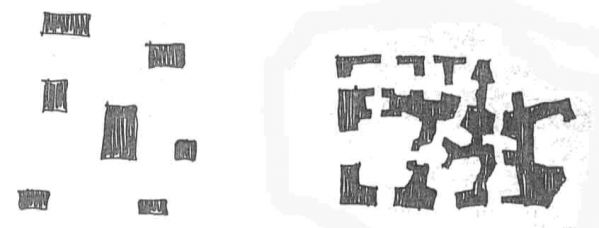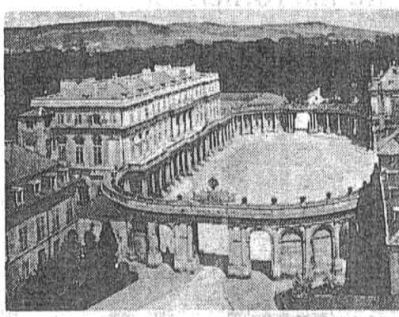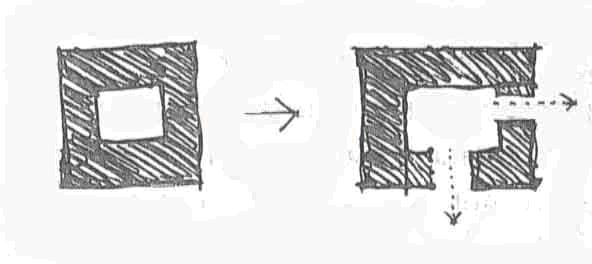Mor Temor
Arch. Mor Temor is international Architecture firm committed to designing unique buildings and one of a kind architectural concepts.

i. The Open Space
The use of Open Space is an indicator of social growth and change (Kiven, 1991). There are two fundamentally different kinds of outdoor space: negative space and positive space (Fig. 11). Outdoor space is negative when it is shapeless, the residue left behind when buildings – which are generally viewed as positive – are placed on the land. An outdoor space is positive when it has a distinct and definite shape, as definite as the shape of a room, and when its shape is as important as the shapes of the buildings which surround it. These two kinds of space have entirely different plan geometries, which may be most easily distinguished by their figure-ground reversal.

Fig. 11 Conceptual diagram for positive and negative space.
If you look at the plan of an environment where outdoor spaces are negative, you see the buildings as figure, and the outdoor space as ground. There is no reversal. It is impossible to see the outdoor space as figure, and the buildings as ground. If you look at the plan of an environment where outdoor spaces are positive, you may see the buildings as figure, and outdoor spaces as ground – and, you may also see the outdoor spaces as figure against the ground of the buildings. The plans have figure-ground reversal.
Another way of defining the difference between "positive" and "negative" outdoor spaces is by their degree of enclosure. Positive spaces are partly enclosed, at least to the extent that their areas seem bounded (even though they are not, in fact, because there are always paths leading out, even whole sides open). Negative spaces are so poorly defined that you cannot really tell where their boundaries are (Fig. 12).

Fig. 12 Another conceptual diagram for positive and negative space.
Now, what is the functional relevance of the distinction between "positive" and "negative" outdoor spaces. We put forward the following hypothesis. People feel comfortable in spaces which are "positive" and use these spaces; people feel relatively uncomfortable in spaces which are "negative" and such spaces tend to remain unused.
The case for this hypothesis has been most fully argued by Camillo Sitte, in City Planning According to Artistic Principles (republished by Random House in 1965). Sitte has analyzed a very large number of European city squares, distinguishing those which seem used and lively from those which don't, trying to account for the success of the lively squares. He shows, with example after example, that the successful ones – those which are greatly used and enjoyed – have two properties. On the one hand, they are partly enclosed; on the other hand, they are also open to one another, so that each one leads into the next.
The fact that people feel more comfortable in a space which is at least partly enclosed is hard to explain. To begin with, it is obviously not always true. For, example, people feel very comfortable indeed on an open beach, or on a rolling plain, where there may be no enclosure at all. But in the smaller outdoor spaces – gardens, parks, walks, plazas – enclosure does, for some reason, seem to create a feeling of security.
It seems likely that the need for enclosure goes back to our most primitive instincts. For example, when a person looks for a place to sit down outdoors, he rarely chooses to sit exposed in the middle of an open space – he usually looks for a tree to put his back against; a hollow in the ground, a natural cleft which will partly enclose and shelter him. Our studies of people's space needs in workplaces show a similar phenomenon. To be comfortable, a person wants a certain amount of enclosure around him and his work – but not too much. Clare Cooper has found the same thing in her study of parks: people seek areas which are partially enclosed and partly open – not too open, not too enclosed (Clare Cooper, Open Space Study, San Francisco Urban Design Study, San Francisco City Planning Dept., 1969).
Most often, positive outdoor spaces is created at the same time that other patterns are created. The following photograph shows one of the few places in the world where a considerable amount of building had no other purpose whatsoever except to create a positive outdoor space. It somehow underlines the pattern's urgency (see Fig. 13).

Fig. 13 The square at Nancy.
When open space is negative, for example, L-shaped – it is always possible to place small buildings, or building projections, or walls in such a way as to break the space into positive pieces.
And when an existing open space is too enclosed, it may be possible to break a hole through the building to open the space up (see Fig. 14).

Fig. 14 Transform close space to positive space.
Therefore: "Make all the outdoor spaces which surround and lie between your buildings positive. Give each one some degree of enclosure; surround each space with wings of buildings, trees, hedges, fences, arcades, and trellised walks, until it becomes an entity with a positive quality and does not spill out indefinitely around corners" (Christopher, 1977).
Arch. Mor Temor